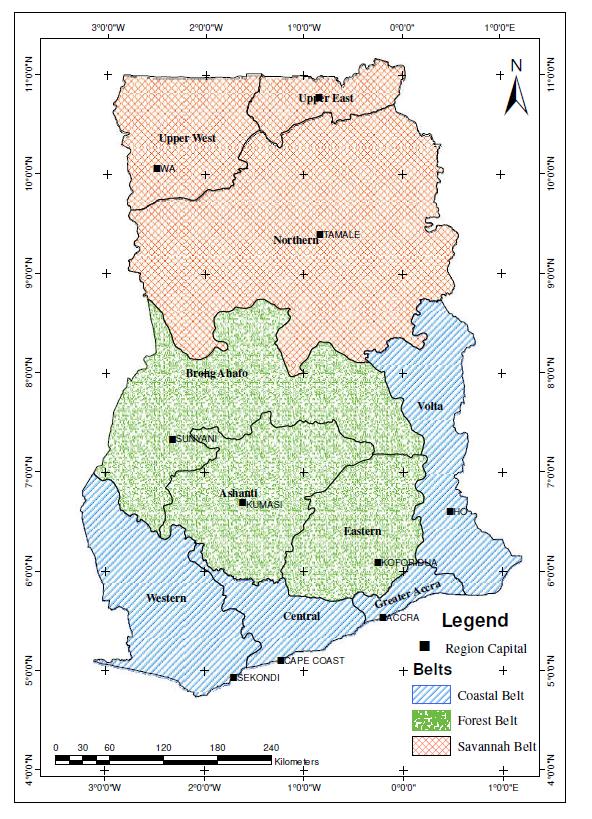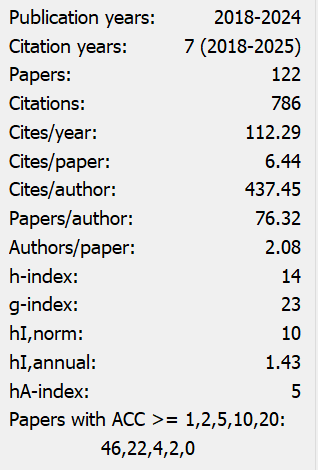Spatial Distribution of Resources and Poverty Incidence in Ghana
Abstract
This paper investigates the spatial distribution of resources, production activities and poverty in Ghana. The study found that the presence of natural resources in an area over a period of time greatly influences industrial activities in that locality. Moreover, given that firms or manufacturing industries will usually site their business ventures close to the sources of resource attraction, the processes of production including value addition, packaging, and refinery largely becomes vibrant in resource rich areas than less-resource zones. In Ghana, there seems to be an uneven distribution of natural resources across the administrative regions and ecological zones. This kind of distribution has resulted in the creation of additional jobs in areas endowed with natural resources. Data for the studies was obtain from Ghana statistical service
Spatial distribution of natural resources positively influences most important production activities in the discovered areas. A boom in production activities within an areas certainly reflect on the poverty incidence of the people since it creates both direct and indirect employment opportunities in that area. The paper suggests diversification of the economy, equitable allocation of resources to deprived areas to ensures comprehensive development and poverty alleviation in all aspects of life of the ordinary Ghanaian .Government needs to as well put in the needed measures to ensure people gets direct benefits from resources exploited in their communities as most of these exploitive activities pose negative externalities to the people.
References
Wen, Q., Shi, L., Ma, C., & Wang, Y. (2018). Spatial heterogeneity of multidimensional poverty at the village level: Loess Plateau. Acta Geogr. Sin. 73, 1850-1864. [Google Scholar]
Hoang Van, Cuong Van and Tran Quang, Tuyen and Nguyen Thi, Yen and LAN Nguyen, Thanh (2019). A propensity score matching analysis of the relationship between forest resources and household welfare in Vietnam.
Adam, M., & Matias, P. (2019). Poverty Alleviation as an Economic Problem. Cambridge Journal of Economics, Oxford University Press, 43(1), 205-221. https://doi.org/10.1093/cje/bey010
Gao, P., Liu, S., Qi, W., & Qi, H. (2020). The Nexus between Poverty and the Environment: A Case Study of Lijiang, China. Sustainability, 12, 1066. https://doi.org/10.3390/su12031066
Gunn, D. (2017, Jan. 26). Why poverty is skyrocketing in the suburbs. Pacific standard.
Adams, D. (2018). Resources Policy. https://doi.org/10.1016/j.resourpol.2018.03.005
Kopiński, D., Polus, A., & Tycholiz, W. (2013). Resource curse or resource disease? Oil in Ghana. Afr. Aff., 112, 583-601. https://doi.org/10.1093/afraf/adt056
African Economic Outlook Report. (2015 & 2016).
Anthonio, D. C., & Aikins, E. D. (2009). Reforming Ghana’s cocoa sector - an evaluation of private participation in marketing. Master Thesis. The Luleå University of Technology Master.
Bervely, L. (2018). Fighting' Galamsey' and River Pollution in Ghana; assessed from http://ghana.gov.gh/index.php/media-center/features/3187-fighting-galamsey-and-river-pollution-in-ghana
Gill & Duffus Group. Cocoa Statistics, various issues
Ghana Statistical Service. (2015). Ghana Poverty Mapping Report.
Gockowski, J., Afari-Sefa, V., Sarpong, D. B., Osei-Asare, Y. B., & Dziwornu, A. K. (2011). Increasing income of Ghanaian cocoa farmers: Is introduction of fine flavor cocoa a viable alternative. Quarterly Journal of International Agriculture.
Ghana Country notes for the African Economic Outlook (AEO, 2015 and 2016) for analysis.
Global Shea Alliance Secretariat (2019). Shea, 2019.
International Cocoa Organization. (2004). International Cocoa Organization annual report 2001/2002. ICCO Annual Report 2001/2002. http://doi.org/10.1108/eb055690
Jebuni, C. (2006). "Development in the North," presentation to the ISSER conference on Economic Development and Northern Ghana, 11-14 September 2006, Bolgatanga and Tamale, Ghana. Retrieved from http://www.saga.cornell.edu/saga/gh0906/ghana0906.html
Land Use and Spatial Planning Authority (LUSPA, previously Town and Country Planning Department, TCPD) (2015a). Spatial Development Framework for the Northern Savannah Ecological Zone (2015-2035) Volume I: Situational Analysis and Major Issues.
McLaughlin, J. L., & Owusu-Ansah, D. (1994). The Colonial Era: British Rule of the Gold Coast. Washington: Federal Research Division, Library of Congress.
Shashi, K., & Marcella, V. (2008). Cocoa In Ghana: Shaping The Success Of An Economy.
The Ghana Poverty and Inequality Report (2016).
UNICEF Ghana. (2013) "Advocating for Development that leaves no Child Behind".
USDA. (2012). Global Agricultural Information Network (GAIN) Report. Accra.
World Bank (2011). Supply Chain Risk Assessment: Cocoa in Ghana. Ghana Cocoa SCRA Report.
WanaGopa – Nyawakan Miller, G.T. & S. Spoolman (2011). Living in the Environment Principles, Connections, and Solutions (17th ed.)


This work is licensed under a Creative Commons Attribution 4.0 International License.
Copyright for this article is retained by the author(s), with first publication rights granted to the journal.
This is an open-access article distributed under the terms and conditions of the Creative Commons Attribution license (http://creativecommons.org/licenses/by/4.0/).


























